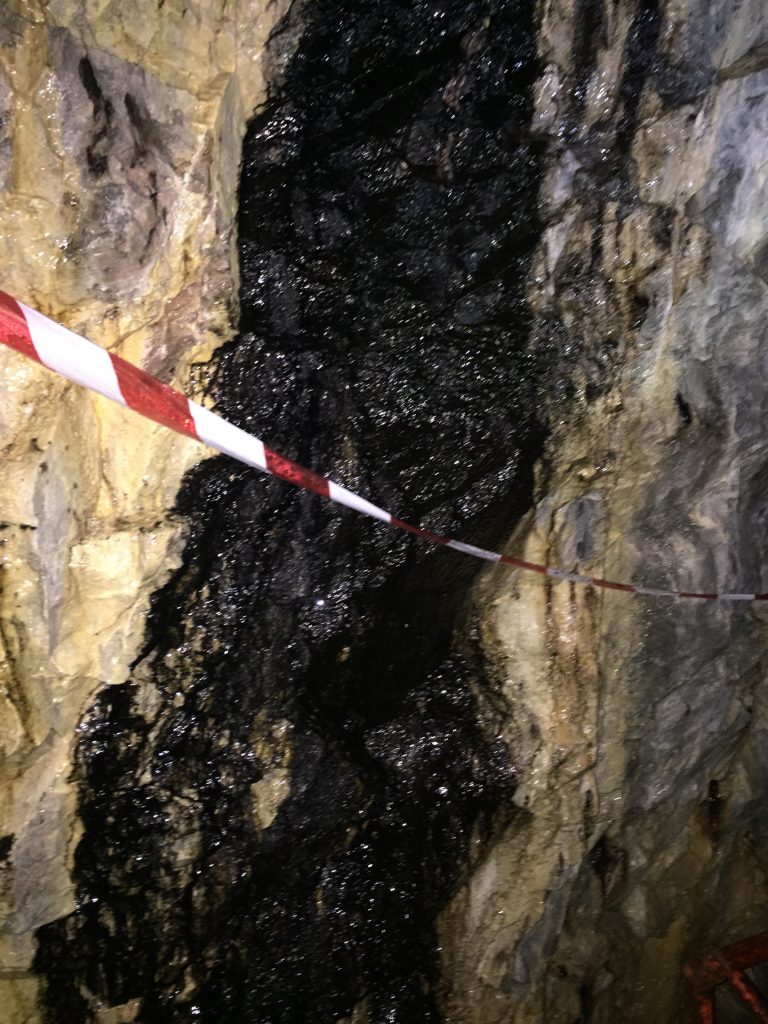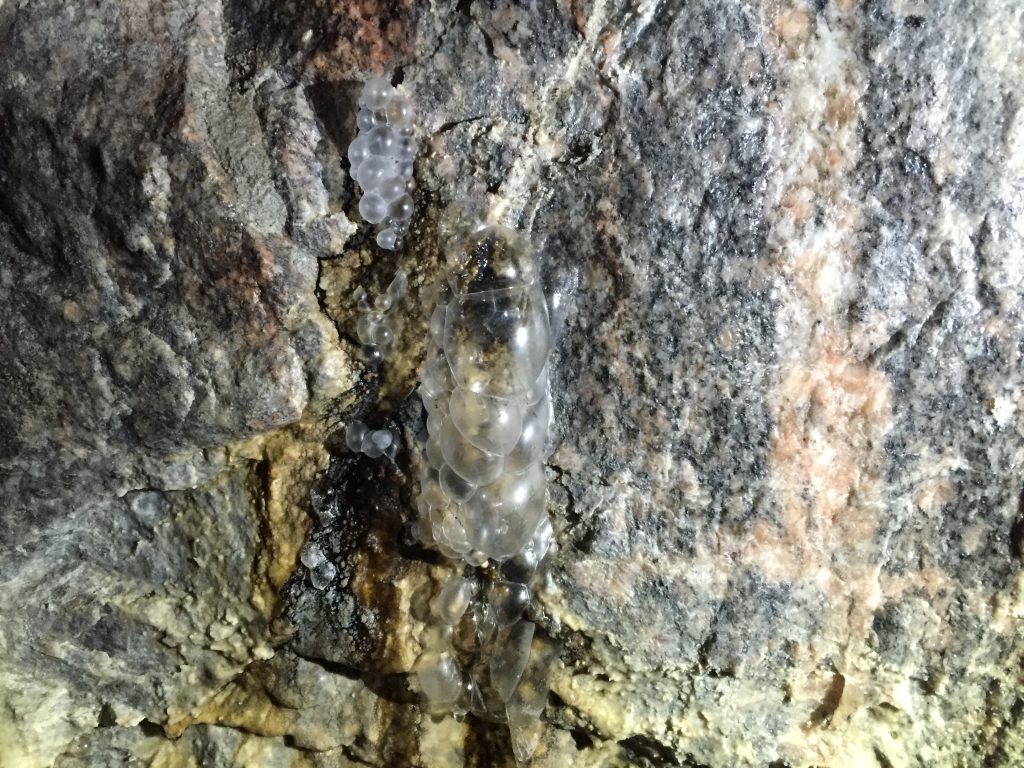Research concerning manganese and carbonate precipitation
In 2012, a master’s thesis related to the Ytterby mine was carried out (Sjöberg, 2012). Water and mineral data were compiled, and the presence of black deposits in water-bearing fractures in the underground tunnel was noted. Analysis of this previously unobserved precipitation became the main purpose of a master’s thesis two years later (Sjöberg, 2014), which in turn became the prelude to the research program that is now underway around the Ytterby mine.

Mineralogy/mineral chemistry
Chemical and mineralogical analysis of the black precipitate (named YBS) that forms in connection with water-bearing cracks in the tunnel leading to the main shaft in Ytterby mine. Analyzes show that this is a variant of the mineral birnessite, which is a manganese oxide that normally also contains sodium and calcium. However, the Ytterby birnessite contains up to 2 wt% REE. This is one of the highest REE levels observed in secondary minerals containing REE (precipitation products, often with iron).
Microbiology
We have identified and characterized the microorganisms (bacteria, archaea, eukaryotes) behind the biogeochemical process that leads to the precipitation of birnessite as well as different types of calcium carbonate (CaCO3) in Ytterby (Sjöberg, 2019; Sjöberg et al, 2018, 2020a, 2020b, 2021). Also products (minerals and organic matter) of microbial origin and associated with the Ytterby birness site have been analyzed and classified. Several different microorganisms have been isolated and identified. Analysis and interpretation of the processes leading to a redistribution of REE from mainly silicate minerals in the pegmatite to a manganese oxide phase generated by microorganisms is ongoing. Also analyzes to understand under which conditions different types of calcium carbonates are formed (e.g. lithified CaCO3 (hard) vs soft CaCO3 often called moonmilk.
Geochemistry/hydrochemistry
Mapping and characterization of the hydrochemical environment in Ytterby mine with water from different geological environments (groundwater, surface water, mine water, Baltic Sea water, etc.). Identification of the transport pathways for REE and manganese that are ultimately united by precipitation in water-bearing air-exposed fracture mouths. Detailed analyzes of water from various environments in and around the Ytterby mine are ongoing.
Chemical speciation
Ongoing development of techniques for the identification of organic metal forms by sequential leaching with organic solvents. Leaching of the manganese precipitate with organic solvents of varying polarity (defined by the solubility parameter, [enthalpy of vaporization/molar volume]0.5) has been tested with the intention of developing a new characterization method. Of particular interest is whether the microbial process that leads to the formation of the Ytterby birnessite also generates organometallic compounds.
Field test of Lab-on-a-chip (in-situ environmental monitoring with a paper roll)
Ongoing tests of a device that makes it possible to easily monitor different species (soluble inorganic carbon, manganese, etc.) in the mine’s water. This work is led by the Department of Materials and Environmental Chemistry, Stockholm University in collaboration with the Department of Geological Sciences (Gimenez-Gomes et al, submitted).
Research concerning oil and microorganisms
Through the analyzes made on fracture water and biofilms in Ytterby, we have identified groups of microorganisms that are capable of breaking down complex hydrocarbons and are probably associated with the previous storage of petroleum products in the mine shaft (Sjöberg et al., 2020b).

Ongoing characterization of microorganisms (fungi) growing in the hydrocarbon affected environment of the mine water, Ytterby. Samples have been taken of the biological flocs that grow in the surface layer of the water-filled mine shaft, where the content of hydrocarbons from the former fuel repository is high. These fungi must be identified, and their ability to break down hydrocarbons studied in detail (Ivarsson M)
Education
The prelude to the ongoing research program was a bachelor’s thesis, followed by a master’s thesis. The projects that have subsequently been started offer good opportunities for biogeochemical site studies suitable within the framework of the geology program at Stockholm University, as well as for degree projects.
6 Parties in ongoing research programs
In the program participates (2016-17)
- Stockholm University (SU), inst. f. geological sciences, contact: Susanne Sjöberg
- Örebro University (ÖU), Human-Technology-Environment (MTM), inst. f. natural science and technology, contact: Bert Allard
- National Museum of Natural History (NRM), dept. f. paleobiology, contact Magnus Ivarsson
Collaboration is also conducted with groups at Linköping University, Lund University and Friedrich Schiller Universität, Jena (Germany).
The three research environments that primarily participate in the program (SU, ÖU, NRM) have good expertise in bedrock geology, geochemistry/biogeochemistry, hydrochemistry, microbiology (bacteria, archaea, micro-eukaryotes (fungi) in the deep biosphere), and the research groups have access to infrastructure in form of laboratories for chemical, microbiological and mineralogical analysis.
Summary
Ytterby mine offers a unique geological environment with opportunities for biogeochemical studies of mineral formation as well as microbial processes, which leads to an increased understanding of the processes of the deep biosphere and artificial underground environments.
An in-depth knowledge of processes and mechanisms behind the ability of microorganisms to mobilize and accumulate metals is obtained, and the role of microorganisms in the breakdown of hydrocarbons (petroleum) in a bedrock environment can be analyzed. Among other things, we carry out controlled cultivations of microorganisms with the ability to accumulate REE in very low concentrations (from groundwater) by forming a manganese precipitate with a high REE content and also of microorganisms with the ability to break down oil residues in a bedrock environment.
Applications for grants for further studies of the redistribution processes of the trace elements (focus on the rare earth metals, REE) in the water and bedrock environment are planned Several premises can be indicated as suitable for these studies (Ytterby, Kvarntorp and possibly Bastnäs and Norra Kärr). The collaboration can be expanded to include researchers from Linnaeus University (National Geological Laboratory NGL; research on processes in deep groundwater in the coastal areas of the Baltic Sea). The possibility of extracting REE from groundwater systems (low levels) through a controlled microbial precipitation process must be considered.
Theses, degree theses, scientific articles
| Title | Author | Year | |
|---|---|---|---|
| Distance-based analytical device for the determination of dissolved inorganic carbon concentration in freshwater. | Gimenez-Gomes P, Hättestrand I, Sjöberg S, Dupraz C, Richardson S, Pamme N | ||
| The Ytterby mine – A historical review and an evaluation of its suggested spatial coupling to multiple sclerosis (MS) | Sjöberg S | 2012 | Bachelor Thesis, Stockholm University (70 p) |
| Characterization of an REE-enriched black substance in fractured bedrock in the Ytterby mine | Sjöberg S | 2014 | Master Thesis, Stockholm University (65 p) |
| REE-enriched Mn-oxide precipitates in water-bearing fractures in the Ytterby mine, Sweden | Sjöberg S, Allard B, Rattray JE, Sjöberg V, Karlsson S | 2016 | TU Bergakademie Freiberg |
| Rare earth element enriched birnessite in water-bearing fractures, the Ytterby mine, Sweden | Sjöberg S, Allard B, Rattray JE, Callac N, Grawunder A, Ivarsson M, Sjöberg V, Karlsson S, Skelton A, Dupraz C | 2017 | Applied Geochemistry |
| Microbial communities inhabiting a rare earth element enriched birnessite-type manganese deposit in the Ytterby mine, Sweden | Sjöberg S, Callac N, Allard B, Smittenberg R, Dupraz C | 2018 | Geomicrobiology Journal |
| Microbially mediated manganese oxides enriched in yttrium and rare earth elements in the Ytterby mine, Sweden | Sjöberg S | 2019 | Ph.D. Thesis, Stockholm University |
| Bubble biofilm: Bacterial colonization of air-air interface | Sjöberg S, Stairs CW, Allard B, Hallberg R, Homa F, Martin T, Ettema TGJ, Dupraz C | 2020 | |
| Microbiomes in a manganese oxide producing ecosystem in the Ytterby mine, Sweden | Sjöberg S, Stairs CW, Allard B, Homa F, Martin T, Sjöberg V, Ettema TJ, Dupraz C | 2020 | |
| Microbe-mediated mn oxidation – a proposed model of mineral formation. Minerals | Sjöberg S, Yu C, Stairs CW, Allard B, Hallberg R, Henriksson S, Åström M, Dupraz C | 2021 |
Presentations at scientific conferences
- Sjöberg S, Rattray JE, Callac N, Allard B, Skelton A, Dupraz C, Ivarsson M, Karlsson S, Sjöberg V, 2015. Putative biogenic signature found in extremely REE enriched black substance, Ytterby mine, Sweden. Goldschmidt 2015, Prague, August 16-21 (Abstract)
- Sjöberg S, Allard B, Rattray JE, Callac N, Skelton A, Dupraz C, Ivarsson M, Karlsson S, Sjöberg V, 2015. Characterization of an REE-enriched black substance in fractured bedrock in the Ytterby mine, Sweden. 14th Symp. on Remediation/14. Sanierungskolloquium Jena, Sept. 30-Oct. 10 (Summary, 1 p)
- Sjöberg S, Allard B, Rattray JE, Callac N, Skelton A, Dupraz C, Ivarsson M, Karlsson S, Sjöberg V, 2016. Microbially mediated formation of a new REE enriched Mn-oxide, Ytterby mine, Sweden. European Geoscience Union General Assembly EGU, Vienna, April 17-22 (Abstract)
- Sjöberg S, Allard B, Rattray JE, Sjöberg V, Karlsson S, 2016. REE-enriched Mn-oxide precipitates in water-bearing fractures in the Ytterby mine, Sweden. Internat. Mine Water Assoc. IMWA 2016, Leipzig, July 11-15 (Abstract and Proc.)
- Allard B, Sjöberg S, 2016. On the formation of an REE enriched manganese oxide precipitate (birnessite) in the fractured crystalline bedrock at Ytterby, Resarö Island (Baltic Sea) – a biogeochemical process. National Geol. Lab. NGL Conf. 2016, Kalmar, Nov. 10-11 (Abstract)
Technical reports
- Reports from Remedy BSAB
- Allard B, 2014. Water from the Ytterby Mine, Resarö. Analysis of water samples. RBS 14-05 P (4s)
- Allard B, 2015. Sequential extraction (leaching) methods. RBS 15-01 R (10 p)